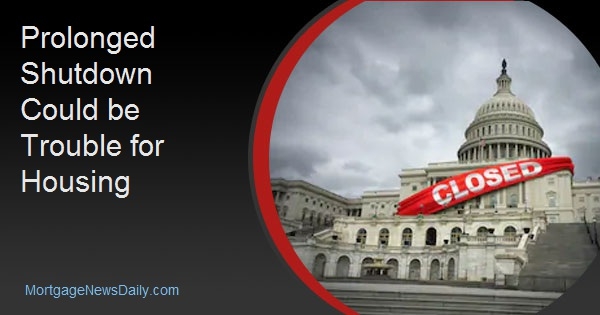Fannie Mae does not expect a lasting impact from the current partial government shutdown, at least if it is over soon. In its January Economic Developments report, the company's Economic and Strategic Research (ESR) Macroeconomic Forecast Team again predicts a slowing in economic growth, down from the estimated pace of 3.1 percent in 2018 to 2.2 percent this year. This moderation, from what they say will probably turn out to be the strongest pace of the recovery, will be due to the fading effects of the fiscal stimulus and tightening financial conditions. They add however that despite the shutdown, the economy will continue to grow, and the current expansion will become the longest on record.
Despite the economic strength in 2018 there were still some evident trouble spots, especially in housing where single-family homebuilding continued to be "lackluster" and home sales declined. The stock market fell sharply near year-end, volatility spiked, corporate credit spreads widened, and the yield curve flattened. The expiration of the Continuing Resolution affected approximately 25 percent of discretionary outlays and the shutdown is the longest on record, but the ESR Team sees some upside offsets from strong employment and wage growth.
Still, the growing downside risks have turned the Federal Reserve more dovish and it is communicating its willingness to be patient about raising rates. The economists believe that a slower pace of rate hikes will help stabilize home sales.
While the forecast is generally upbeat, Fannie Mae does see downside risks. If stock market volatility continues it could lower confidence and curtail spending. The Conference Board's consumer confidence index posted the largest monthly decline in three years in December as the expectations component plunged the most in five years. Slower growth abroad could limit foreign demand for U.S. goods and services and the continuing uncertainty about trade presents an additional hurdle.
Then there is the downside risk of the shutdown dragging on. The Bank of America Merrill Lynch suggests that every two weeks of shutdown will shave 0.1 percentage point off of growth. In addition, business may temporarily forgo investment because of the uncertainty. The shutdown has also delayed economic data releases from several agencies including the Bureau of Economic Analysis and the Census Bureau which eliminates information needed to assess the economy. Market stresses will increase if the shutdown extends into the debate on the debt ceiling which must be reviewed by March 2.
The partial shutdown will also have ramifications for housing. Homeowners who are furloughed, working without pay, or laid off from their contracting jobs may have difficulty meeting their monthly mortgage payments which could evolve into rising delinquencies, defaults, even foreclosures. Prospective homebuyers affected by the shutdown may delay a home purchase and this could spread to those not affected if the shutdown undermines broader consumer confidence.
Fannie Mae's Home Purchase Sentiment Index declined in December even though the underlying survey was completed before the shutdown began. Results from the January release could reflect post-shutdown responses. A third impact could be disruption of some federal mortgage programs. The closure of the U.S. Department of Agriculture has halted activities under its Direct and Guaranteed Loan programs. While the Federal Housing Administration is open, it is operating with reduced staff, which may delay endorsements.
Beyond those risks, Fannie Mae expects home sales to stabilize this year after declining in 2018. Mortgage rates are expected to change little in 2019 from their level late last year of around 4.5 percent, allowing potential homebuyers time to adjust to the rate environment after the volatility experienced in 2018. Home price increases should slow, from 5.5 percent in 2018 to 4.2 percent this year according to the company's forecast. At the same time, the prediction for continued job growth implies that the unemployment rate will remain near historic lows - a positive for wage growth and affordability.
Single-family construction will grow modestly this year and lower interest rates should help builders with their borrowing costs. Multifamily construction, which has had a solid run since 2010, is expected to retreat but will be supported by continued household formations by Millennials. Total residential investment, which contracted last year for the first time in seven years, is projected to rebound
The forecast for purchase mortgage originations last year and this remain the same as last month, but have been upgraded slightly for 2020, due to a more optimistic view of home price growth. Lower mortgage rates have led to an increase of $10 billion and $6 billion in projected refinances in 2019 and 2020 respectively, but refinance volumes are still expected to decline.







